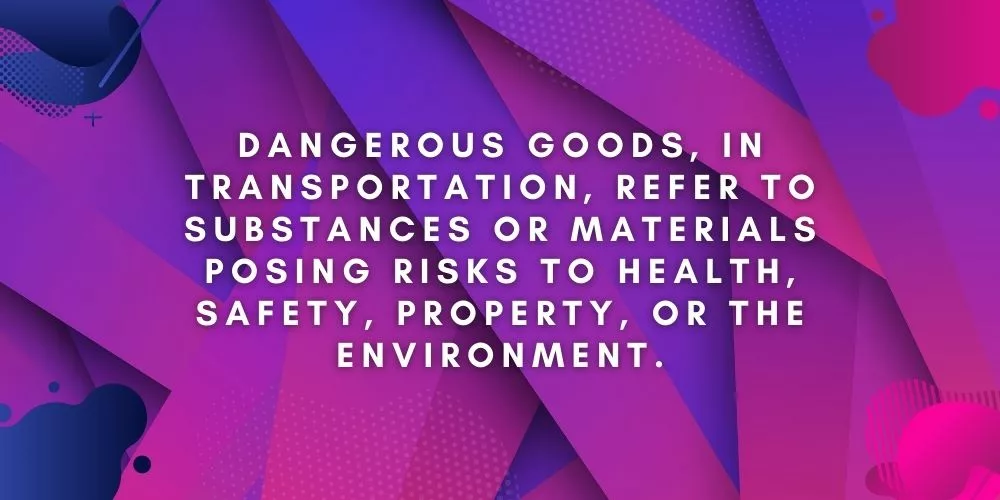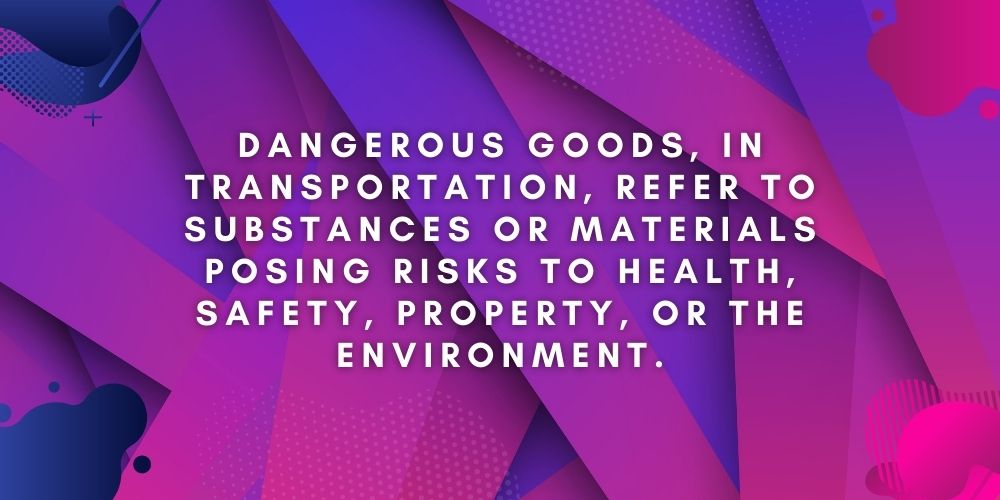What are Dangerous Goods, Regulation, and Training Course for Transportation of Dangerous Goods in Canada 2023
Whether it’s flammable liquids, radioactive materials, or hazardous chemicals, transporting dangerous goods is a critical yet challenging component of Canada’s supply chain.
Navigating these complexities requires a profound understanding of intricate regulations, safety measures, and industry best practices.
In this comprehensive guide, we dive deep into the realm of dangerous goods transportation in Canada. We will shed light on its nuances and equip you with critical knowledge to ensure risk-free, efficient processes.
Don’t Miss Out Buy Now – Dangerous Goods Training for Air Shippers
Understanding Dangerous Goods: Classification and Identification
Transporting dangerous goods in Canada is fraught with risks. Nevertheless, these can be effectively managed through a stringent regulatory framework, efficient identification of materials, and comprehensive training programs.
What are Dangerous Goods?
Dangerous goods, in transportation, refer to substances or materials posing risks to health, safety, property, or the environment. Typically, these goods fall into nine distinct classes, each representing a specific type of risk.
For example, Class 1 encompasses explosives, while Class 7 pertains to radioactive materials.
Buy Now – Online Transportation Training Courses
How Are Dangerous Goods Identified?
The identification of dangerous goods is a crucial step in their safe transportation. Transport Canada provides specific criteria for each class of dangerous goods. Identification is achieved through labels, placards, shipping documents, and safety marks communicating inherent risks.
Transportation of Dangerous Goods in Canada Regulations
All stakeholders involved in the process of transportation of dangerous goods must understand, adhere to, and enhance these safety measures. It ensures seamless, efficient, and safe transportation of dangerous goods across Canada’s extensive territories.
The goal here is to facilitate the smooth operation of Canada’s supply chain while ensuring maximum safety for personnel, the public, and the environment.
The Transportation of Dangerous Goods Act (TDGA)
The TDGA provides a legal framework for the safe transportation of dangerous goods within Canada. It directs handling, documentation, and emergency response, among other aspects. The Act also specifies penalties for non-compliance, emphasizing the importance of adhering to set standards.
The Role of Transport Canada
As the regulator, Transport Canada oversees the TDGA implementation, ensuring compliance through inspections, security plans, and certification processes. This entity also offers training programs to improve the competence of those involved in transporting dangerous goods.
Buy Now – International Maritime Dangerous Goods Course
Course Overview: Canadian Dangerous Goods Transportation Compliance (TDGR)
Navigating the complexities of dangerous goods transportation in Canada is both necessary and challenging for professionals in the industry.
Course Objectives-Structure
The “Canadian Dangerous Goods Transportation Compliance (TDGR) – 2020″ course, developed by Currie Associates, is a robust resource for any professional working in the dangerous goods transportation sector.
Learning Objectives
The course aims to equip participants with an understanding of the TDG Regulations. It provides a roadmap to classify, identify, package, document, and understand ERAP requirements for the safe transportation of dangerous goods.
This knowledge ensures a competent, well-trained workforce capable of mitigating risks associated with dangerous goods transportation.
Course Modules
The course is divided into eight modules, each dealing with an essential aspect of dangerous goods transportation:
- Introduction to the TDG Regulations
- Classification
- Documentation
- Safety Marks on Small Means of Containment
- Safety Marks on Large Means of Containment
- Means of Containment
- ERAPs and Reporting
- Cross Border US-Canada
This module-based approach makes understanding the complex TDGR easier.
Target Audience
This course is essential for shippers, carriers, freight forwarders, and anyone involved in handling, offering for transport, or transporting dangerous goods by ground within Canada.
It caters to both employees and their supervisors, ensuring a comprehensive understanding of TDGR across all operational levels.
Regulatory Texts and Recommended Resources
The course requires the use of TDG Canada Regulations as a reference, available either as a free download or a purchasable book.
Other recommended resources include the TP14850, DOT Chart 17, and the Emergency Response Guidebook 2020, all available for free download.
Course Features and Prerequisites
The course requires no prerequisites. It runs for approximately 3 hours and 10 minutes and is delivered in English. A final assessment validates participants’ understanding of the material.
Learners receive a training certificate upon successful completion.
Implementing Safe and Effective Transportation Practices
In the face of potential risks, implementing safe and effective transportation practices are your first line of defense. With this, you can turn the risky into the secure.
Below are the points that are required to implement safe and effective transportation practices.
Training and Certification
Mandatory training is required for individuals involved in the transportation of dangerous goods. This group includes drivers, loaders, and others whose duties involve dangerous goods.
Training equips them with the knowledge and skills to handle emergencies and comprehend the risks involved.
Emergency Response Assistance Plans (ERAPs)
ERAPs are strategies for responding to incidents during the transportation of dangerous goods. Approved by Transport Canada, these plans outline steps to mitigate harm during emergencies, from containment strategies to rescue operations.
Must Read – A Comprehensive Guide To Dangerous Goods Training Course 2023
Unpacking the Key Elements of the Transportation of Dangerous Goods Regulations (TDGR)
The Transportation of Dangerous Goods Regulations (TGDR) equips individuals with the knowledge and skills to handle and transport dangerous goods within Canada safely,
The Nature and Purpose of the TDGR
The TDGR forms the core of Canada’s approach to handling dangerous goods. Created by Transport Canada, the TDGR details the necessary aspects for implementing the Transportation of Dangerous Goods Act (TDGA).
The primary purpose of the TDGR is to promote public safety while transporting dangerous goods. It sets clear and stringent standards for classification, documentation, packaging and containment, incident reporting, and safety marks.
Diving Deeper into the TDGR: Key Components
The TDGR is not just a regulatory obligation – it’s a commitment to safety, professionalism, and excellence in one of Canada’s most critical sectors.
By becoming familiar with these regulations, anyone involved in the transportation of dangerous goods can do the following:
- Help maintain high safety standards;
- Protect public health and the environment;
- Ensure the smooth functioning of Canada’s essential supply chains.
Classification and Schedules
The TDGR employs a meticulous classification system presented in schedules detailing the characteristics and criteria of dangerous goods. This classification plays a vital role in identifying goods, understanding potential hazards, and determining appropriate handling and transportation measures.
Packaging and Means of Containment
Packaging and containment is one of the critical areas the TDGR covers. It specifies standards for selecting and using packages and containers to ensure the safe transportation of dangerous goods. Guidelines include proper sealing, labeling, and use of containment that can withstand transportation stresses.
Safety Marks
The regulations detail the safety marks (e.g., labels and placards) for different classes of dangerous goods. These marks provide quick, visual information about the nature and risk level of the goods, helping ensure their safe handling and transport.
Documentation
The TDGR outlines requirements for shipping documents that must accompany the transportation of dangerous goods. These documents provide crucial information about the goods, including their classification, quantity, and emergency response information.
Incident Reporting and Emergency Measures
The TDGR stipulates the procedures to follow in an accident or emergency involving dangerous goods. It includes immediate and 30-day reporting requirements and guidelines for emergency measures to mitigate the consequences of an incident.
Coggno: A Leading Platform for Comprehensive Learning
Coggno, with its expansive course offerings, user-friendly platform, and flexible, interactive learning experiences, is an excellent choice for your professional development needs.
Whether you’re looking to learn about transporting dangerous goods in Canada or explore other professional fields, Coggno provides a rich, reliable, and convenient platform for your learning journey.
Why Choose Coggno?
Choosing the right learning platform is as important as the course content itself. Coggno stands out as a top choice for various reasons, especially for a course as comprehensive and detailed as the “Canadian Dangerous Goods Transportation Compliance (TDGR) – 2020.“
Rich Repository of Courses
Coggno hosts an extensive catalog of training courses catering to various professional fields. This variety ensures you can find the course you need, often alongside related courses that supplement your learning.
User-Friendly Interface
Coggno offers a straightforward, user-friendly platform, making the process of finding and enrolling in courses seamless. The platform’s clean design and easy navigation ensure your focus stays on learning rather than figuring out how to use the platform.
Trusted by Professionals
Professionals worldwide trust Coggno. It’s known for high-quality course offerings often developed by industry leaders and experts like Currie Associates. This trust reflects consistently delivering valuable, relevant, and up-to-date content.
Interactive Learning Experience
Coggno provides an interactive learning experience that can increase understanding and retention of course material. Through videos, quizzes, and interactive content, you can engage with the course material in a way that suits your learning style.
Accessibility and Flexibility
One of the key benefits of Coggno is its online nature, providing accessibility and flexibility. You can access your course anywhere, at any time, learning at your own pace and schedule. This flexibility makes it easier to fit learning into your busy schedule.
Certification and Tracking
Coggno offers a certificate upon course completion and keeps track of your progress throughout. This tracking can be useful for employers who need to ensure their employees have completed mandatory training courses like TDGR 2020.
Empowering Safe and Efficient Transportation of Dangerous Goods in Canada — Closing
Navigating the complex landscape of dangerous goods transportation in Canada, a vital artery in the country’s supply chain is both challenging and indispensable. Stringent adherence to regulations like the TDGR and TDGA ensures a risk-free, efficient process.
The “Canadian Dangerous Goods Transportation Compliance (TDGR) – 2020” course offered by Currie Associates is a comprehensive and effective learning resource designed to equip you with this critical knowledge.
And with the added convenience and interactive learning experience provided by the Coggno online platform, gaining this expertise becomes a seamless process that fits into your professional schedule.
Frequently Bought Courses:
- Hazardous Materials Transportation
- Safe And Compliant Transportation Of Excepted Lithium Batteries By Ground
- 49 CFR, General Awareness, Function Specific, Safety & Security Compliance
- Transporting Limited Quantities Of Dangerous Goods By All Modes (49 CFR, Canadian TDGR
- Mexican Regulation For Ground Transport Of Hazardous Materials And Waste




















